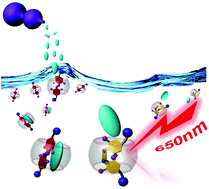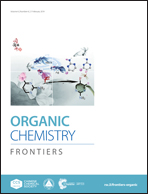Red-light-responsive molecular encapsulation in water: an ideal combination of photochemistry and host–guest interaction†‡
Abstract
A major limitation in the application of light-responsive host–guest complex-based photoresponsive materials in living organisms is the lack of reliable photocontrollable recognition motifs activated beyond UV light, especially by the light within a biological window (650–1450 nm). Herein, we present long wavelength light-responsive cucurbit[8]uril (CB[8])-mediated binary host–guest complexes, in which the encapsulated photoisomerizable azobenzene-derived guests exhibit high E → Z photoisomerization ratios upon irradiation of yellow (>500 nm) or red (650 nm) lights. The non-irradiated binary host–guest complexes can further serve as supramolecular nanocontainers to uptake second guests (e.g., selected drug molecules). Moreover, “on command” release of the non-photoactive molecular cargos can be triggered by irradiating the resulting CB[8]-mediated heteroternary host–guest complexes with yellow or red lights. Due to activation within the biological window with high photoisomerization ratio, the specific red-light-responsive CB[8]-mediated heteroternary host–guest complexation is expected to be a promising tool in the extensive applications of photopharmacotherapy, drug delivery and biocompatible dynamic materials.

- This article is part of the themed collection: In celebration of Julius Rebek’s 75th Birthday


 Please wait while we load your content...
Please wait while we load your content...